Ice in eavestroughs and downspouts
 1/4/2018 at 5:13:23 PM
1/4/2018 at 5:13:23 PM
I have a small single-story, no-attic house whose roof runs in a shallow slope from one end to the other -- then flattens out (or even slopes very slightly "backwards") as it extends over the attached carport. The entire roof area drains to two 4" round-section vinyl eavestroughs and 3" diameter round vinyl downspouts (the biggest I can find), at the front and back of the house at the house / carport junction. I've tried to minimize the angles in the downspouts, they're as straight as they can be.
This is Quebec, and we get snow and cold weather. Snow on the roof seems to stay at a consistent thickness (as far as I can tell without getting up on the roof in the winter), so the roof (ceiling) insulation seems basically OK. Every winter, the downspouts freeze solid and the eavestroughs fill up with ice and develop icicles. On sunny days, they drip like mad and result in sheets of ice encasing the downspouts and spreading across the ground.
How can I prevent this ice blockage? There are a few other houses in the neighbourhood that are built to the same design, and they don't seem to have anything near the same ice buildup that I do. Most of them use the rectangular 2"x3" aluminum type of eavestroughs and downspouts. I chose the vinyl because a) it has a bigger cross-section and should be able to deal with more water volume, and b) plastic conducts heat/cold less than metal. Wrong choice?
 1/5/2018 at 7:58:23 AM
1/5/2018 at 7:58:23 AM
Hi Reda:
Although I can only speak to what we see here in Ontario, I'm hoping that my response may provide some direction for you.
Ice build up in the eaves is generally the result of an incorrect slope of the troughs themselves. Eavestroughs are never supposed to be completely straight -- although they may look straight to the naked eye, all eaves should be slightly sloped to provide a path for the water to drain towards the downspouts. The placement of the downspouts and the total length of the run of the troughs will also play a part. You didn't mention the square footage of the house, but even a small house with a low slope roof line should be draining into at least 3-4 downpipes (you mentioned you only have 2).
If there is standing water in the eaves due to incorrect or poor sloping of the troughs then that water will freeze in cold temperatures and create a scenario where additional snow/water/ice will build on top of it. Perhaps this is what has happened with your home.
As far as the type of materials you've chosen for the downpipes (vinyl), I can't speak to this choice because it's not widely used here in Ontario. I would, however, suggest that you look to increase the size of the downpipes to 5" or even 6" to allow for better water distribution. Of course, this won't make a difference if the troughs aren't sloped correctly, so I would recommend you start there.
Hope this helped a little.
 1/5/2018 at 11:24:46 AM
1/5/2018 at 11:24:46 AM
I would recommend having an eavestrough company install heated coils all around the perimeter of your roof 2 feet up from the eaves trough. You can also get 5 in Eve troughs and bigger downspouts as well.
 1/5/2018 at 3:19:26 PM
1/5/2018 at 3:19:26 PM
As suggested, here are a few photos (sorry for poor quality, it's -30 outside so I snapped fast!) I think the eavestroughs are sloped as much as possible, and I don't know where I could put more downspouts or how heating coils around the perimeter of my roof would help - but I'm sure willing to learn. Also, where could I get bigger diameter downspouts? Thanks.
Edit: looks like the photos didn't attach. I'll try again....
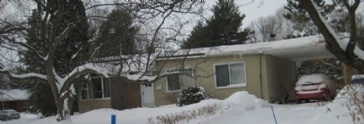
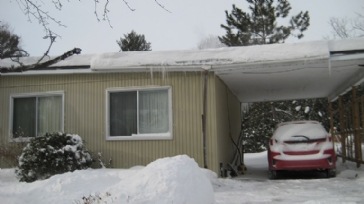
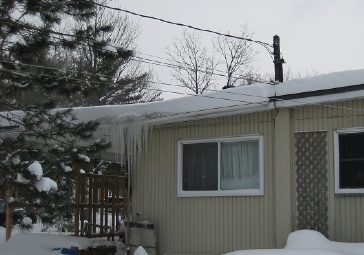
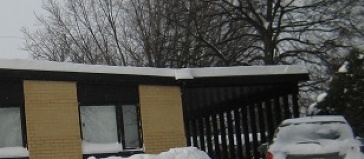
 1/5/2018 at 8:02:20 PM
1/5/2018 at 8:02:20 PM
In case it's not clear, photos show my house (front and back) and for comparison a pic of a neighbour's house, same design except they have a tiny little section of eavestrough, a metal downspout with a couple of tight bends -- and no icicles.
 1/9/2018 at 7:43:03 AM
1/9/2018 at 7:43:03 AM
It's hard to tell from the photos, and it could just be all the snow in the way, but the troughs don't looked like they're sloped properly at all. It appears that they are sloped towards the junction where the car port is (looks like a dip in the structure there) -- they should be sloped towards the edges of the home and drain into the downspouts. Or at least there should be a downspout located at the junction where the house ends and the car port begins.
Aside from that, there's a tremendous amount of ice damming that's visible. This is a result of inadequate air flow and also improper slope/drainage. I would recommend you have an eavestrough company come inspect the home in the spring and get their take on the slope and downspout placement. You may also want to have a roofing company perform an assessment to see if there's any way to increase the ventilation of the home (since you don't have an attic).
You can buy larger downpipes at any home improvement store (Home Depot, Lowes, Rona, etc.).
 1/9/2018 at 11:21:39 AM
1/9/2018 at 11:21:39 AM
Thanks for your response. Apologies for the poor photos. And sorry to be so dense, but I don't yet understand "they should be sloped towards the edges of the home". The lowest points in the roofline are indeed at the junctions (front and back) of the house and carport, and I do have downspouts there, (eavestroughs white, downspouts brown -- don't ask.) The support post for the front downspout is a bit out of alignment which may make the pipe look a little kinked in the photo, but it's not.) My 3" round downspouts are the biggest I can find on the home improvement websites (Rona; biggest at the others is the 2x3" rectangular section). Next step up might be 4" sewer pipe.
It would be so much more sensible if the carport roof continued the slope of the house. What was the architect thinking!
 1/9/2018 at 12:06:35 PM
1/9/2018 at 12:06:35 PM
See the photos I updated. Best thing to do would be to have an eavestrough company come in and evaluate. Perhaps a custom diameter downpipe needs to be fabricated, which they would be able to do without issue.
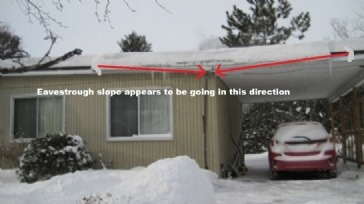
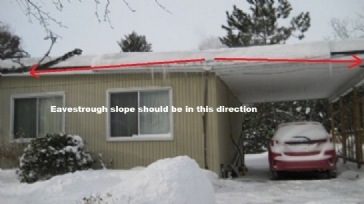
 2/6/2018 at 4:53:48 PM
2/6/2018 at 4:53:48 PM
Even with the photos provided (which are very unclear), its very difficult to diagnose your issue. The best bet would be to have a professional inspect it. Some additional info I can provide is that when sloping the eavestroughs, use a level and do not eye it based on the fascia because most of the time the fascia is not level. Depending on the volume of the roof water, the eavestrough might not be draining fast enough and after a rain fall during the day, when the temps go into freezing overnight, any water not drained will freeze up and then keep icing over. Also make sure the outlet hole is the size of the 3x3 downspout, otherwise having a larger downspout is pointless if the outlet hole is 2x3 or smaller. Even something like the use of longer then needed screws where the downspout is attached to the eavestrough can catch debris that will restrict flow. Too many variables without seeing it in person. Hope you figure it out!
 2/18/2018 at 10:31:54 AM
2/18/2018 at 10:31:54 AM
Hi Reda,
First off, I believe you have identified where the downspout should be located. I suggest you go the route of your neighbours and go with a small eaves trough at the point at where the 2 roofs meet. From what I can see, the rest of the eaves trough aren't functioning properly to catch the water runoff, because roof is not pitched towards the eaves trough. The roof, which looks flat, is pitched so that all the water goes to where the two roofs meet.
My suggestion, disconnect the eaves trough that runs over the house and garage and keep a small eaves trough with a downspout where the roofs meet. I would also add one at the back of the house. You may or may not need to use a heating cable to keep the downspout clear of ice build up.
I am curious; what's the roofing material?
Steve Edan
Edan Home Repair and Contracting
 2/21/2018 at 3:49:59 PM
2/21/2018 at 3:49:59 PM
Thanks again to everyone for their suggestions. Steve, you are right, smaller eavestroughs would be enough to catch the rainwater runoff at the low point at the junction of the two roofs, where the current downspouts are (front and back). But I'm thinking that it might be good to move the downspouts to the far side of the carport, and extend/shift the eavestroughs (front and back) from the low point at the junction of the two roofs across the whole width of the carport, re-sloping them as much as possible (per Mike and Patrick's suggestions) to the (new, bigger) downspouts at the far side of the carport. Even without the ice issues, it will be good to have rainwater draining farther away from the house. A bigger downspout should help the freezing-solid issue in the winter, and with the new configuration even if ice continues to build up back into the eavestroughs, at least it would then be mostly be over the carport rather than the house. Sound like a plan? As for the roofing material: I'm not sure what it is called, but it's a sort of membrane with grit embedded in it, comes in rolls, installation involves torches, and is meant to be a newer form of tar and gravel. So far I've been quite satisfied with it.
Search the TrustedPros directory and discover the best contractors in your area.
Find your home service pro

